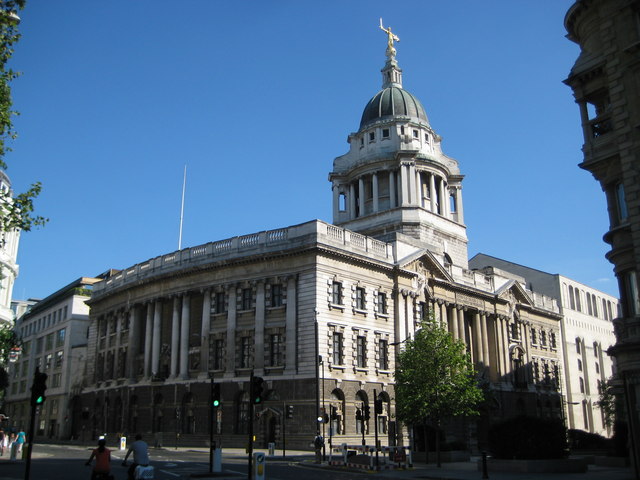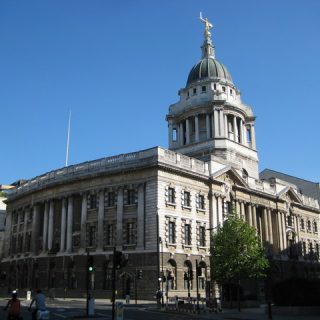All of our first year law undergrads took part in an exercise in week one of their LLB where they escaped City and went to visit a number of buildings of significance in the local area, before tackling some research questions.
They were then asked to write a blog post inspired by their travels. 21 winners were selected from all those posts submitted – this is one of those – thanks to Andrew Mitrousis.
The history of London’s legal heart resides in the grand architecture of its buildings; despite the threat of being overshadowed by the numerous modern skyscrapers around them, they still elicit as much stoic majesty as they ever did.
The Old Bailey, one of the most famous criminal courts in the world, characterises
this especially. Carrying a history of media attention with its imposing aesthetic, it undoubtedly holds a longstanding reputation of being the forefront of new legal ideas; its
architectural changes over the years coincides with the more pragmatic nature of UK Law,
often constructing a whole room or feature of the building to suit the needs of new proposals.
One such example in the early nineteenth century exemplifies this, before the invention of
gas lighting, comes to mind. Courts struggled to analyse the facial expressions of those
giving testimony in an era where such words could not be confirmed with a modern
swiftness, as many signs as possible were needed to draw a relatively sound conclusion.
The solution was to install a large mirrored reflector placed above the bar, which reflected
the light of the windows onto the faces of the accused (1) . A simple and perhaps primitive idea, and inherently a temporary solution, but it is still contextually important in viewing how the courts’ ability to adapt in the midst of pressing needs.
Any changes deemed unconstructive are either simply changed back or evolved further. In
1673 an open air building was brought to the structure, with crowds of varied backgrounds
being attracted to the spectacle. It is even stated that criminals would attend in order to
devise strategies for defending themselves in case they ever go on trial! Additionally, the
crowd’s presence would be known to influence, or even intimidate, the jurors sitting inside. In 1737 the building was remodelled, and enclosed although
allegedly to keep out the weather, the City authorities were likely to have wanted to limit the spectators’ influence.
Now, while civilians can attend trials, it is extensively controlled and any impact on the
verdict diminished to a negligible amount.
Interestingly, the Old Bailey’s depiction of Lady Justice is the only notable example not to
include a blindfold on the figure. However, as explained in the courthouse brochures, her
original form did not include one , her “maidenly form” supposedly guaranteeing her
impartiality and thus rendering the blindfold redundant (2). Gregory G. Colomb mentions that by 1699 Justice’s blindfold was “key … in the conventional iconography”, yet without her blindfold represented “an emblem of invested interest.” For the Old Bailey to depict it in a manner that was contextually unconventional seemed as daring as any architectural
revision, and reminds us again of its historically unique status.

Despite the considerable damage from the Blitz in 1941 and an attack from the IRA in 1973 (3), the current building stands resiliently today as a continuation of the design philosophy’s legacy. The previous courtrooms, feeling the strain of an insufficient ability to hold all those seeking to watch in the ever-lengthening trials, were forced a dramatic rebirth following a fire in 1877. Of note was the fact that the neighbouring prison, Newgate, no longer held longterm prisoners and was pulled down, the space now making room for an even larger Old Bailey. Designed by E.W. Mountford in a neoBaroque style, the domed structure and the adornment of the words “defend the children of the poor and punish the wrongdoer” were such details that reminded the public of its purpose: a servant to the Lady that sits on top of it dome, and a house of the common law that drives her will to the people.
(1) Clive Emsley, Tim Hitchcock and Robert Shoemaker, ‘Historical Background History
of The Old Bailey Courthouse’, ( Old Bailey Proceedings Online , 1 March 2003)
< https://www.oldbaileyonline.org/static/Theoldbailey.jsp > accessed 3rd October 2015
(2) Gregory Colomb, Designs on Truth , (first published 1988, Penn State Press 1992) 50
(3) Richard Cavendish, ‘Formal Opening of the Old Bailey’, History Today , 2nd February 2007)< http://www.historytoday.com/richardcavendish/formalopeningoldbailey> accessed 4th October


